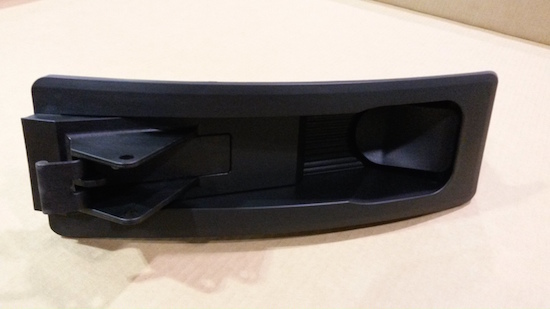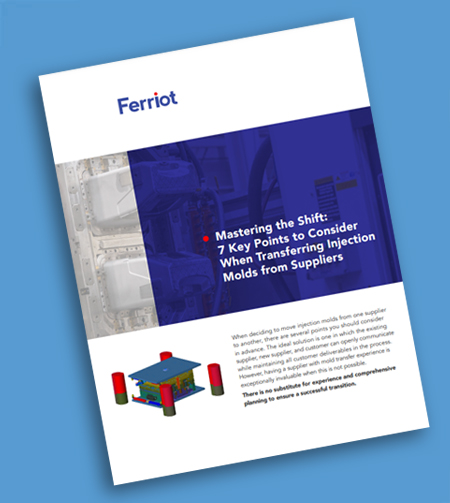Designing custom molds for your injection molded products can be a complex process. However, working with the right team can greatly reduce the complexity and cost while improving the quality of the completed part and minimizing the length of the production cycle. Take the time to answer the following questions before you attempt to design molds for injection molding.
- How will the part be used?
- How will this component integrate with other parts in the final assembly?
- What kinds of loads and pressure will it be subjected to?
Aside from determining core function and structural features, the injection molding process itself is a factor to consider. A part’s features must be reviewed carefully in terms of how the resin material enters and fills the mold cavity, as well as how the material cools while in the mold. An experienced tool design engineer understands how to control mold temperature and cooling rate process optimization. This critical step will help to optimize cycle times, reduce stress in the part and prevent various physical and cosmetic defects. The result is a stronger part that is easier to manufacture.
Molded Part Applications

Injection molding has long been the most popular method for manufacturing plastic parts. In fact, at any given moment, you can likely find several products that were injection molded, including the pen you use, your smartphone’s body, bottle caps, many types of plastic containers and housings, car components and interiors, computer keyboards, and so many others. Injection molding is ideal is for high volume production runs. With the right setup and tooling, several components can be produced in a single cycle with high tolerances, low labor costs, and minimal parts finishing. That being said, the single greatest drawback to injection molding is the initial upfront costs for creating custom molds and tooling. That is why getting the mold design right is so important.
How Polymers Affect Mold Design
Part designers can choose from literally thousands of different resins for an injection molding process. Most of these resins are thermoplastics, but some elastomers are also available. When deciding on which resin to use for a particular part, it’s important to weigh a resin’s flexibility, moldability, strength, and cost; these factors will also have an impact on the choice of mold material. The various metals that can go into a mold offer a variety of temperature handling capabilities and often respond in different ways to various processes. Consider how many parts you will need to manufacture and how often when creating a custom mold design. For example, molds cut from steel last longer and can typically handle more injection molding cycles than an aluminum one, but steel tends to be costlier. Does your project require the strongest materials or will less durable ones suit your needs? How many molds do you need to build at a time? How many do you need running at a time? How many do you need to reserve as backups?
How Molding Machines Affect Mold Design
Just as with resins, there’s a wide variety of injection molding machines to choose from – each with its own set of capabilities. They typically all have the same components: a material hopper, an injection ram or screw plunger, and a heating unit. Once molds are clamped to the machine and in the ready position, melted plastic is injected into the mold. Machines are rated by tonnage, which indicates how much clamping force the unit can exert. Machine tonnages typically range from 5 tons to 6,000 tons. Larger parts require higher tonnage machines to exert enough force to spread molten resin quickly through the mold cavity. To determine machine tonnage required, the projected area of the part is multiplied by a clamp force factor ranging from 2 to 8 tons per square inch of the projected area. As a general rule of thumb, a clamp force of 4 or 5 tons per square inch is sufficient for most products. Less flexible materials will require more pressure to fill the mold properly.
Custom Mold Construction
A mold, sometimes called a die or tool, represents a major portion of the costs associated with injection molding for most manufacturers because they often pay for designing and manufacturing their own molds, then loan them out to full-service contract manufacturers to carry out the actual injection molding process. Injection molds are usually cut from hardened steel, pre-hardened steel, aluminum, or a beryllium-copper alloy. The choice of material to use for your custom mold typically comes down to what makes the most sense financially. It is important to focus on the long-term cost versus up-front tooling cost. Hardened steel molds are more expensive to produce, but their wear-resistant characteristics allow for longer working lifespans and require less maintenance. Standard tool steels are less expensive, but they usually offer a shorter lifespan and require more maintenance.
Aluminum molds can be significantly less costly than steel molds and are usually intended for lower quantity production parts. Molds made of higher quality aluminum, such as QC-7 and QC-10, can produce hundreds of thousands of parts. Aluminum molds also have another advantage; they offer better heat dissipation properties than steel molds, so cycle times are shorter, allowing for quicker turnarounds. Aluminum molds can also be coated to help them withstand the heat and pressure longer, extending their useful life.
For parts that require higher temperatures than typical injection molded parts or fast heat removal, beryllium-copper molds are the best option.
Injection Molding Methods
A variety of molding methods are available for products or molds that demand specific techniques. To make more informed decisions, familiarize yourself with the different approaches to injection molding before finalizing your custom mold design.
- Co-injection (sandwich) molding
- Fusible (lost, soluble) core injection molding
- Gas-assisted injection molding
- In-mold decoration and in-mold lamination
- Injection-compression molding
- Injection molding of liquid silicone rubber
- Insert and outsert molding
- Lamellar (microlayer) injection molding
- Low-pressure injection molding
- Microinjection molding
- Microcellular molding
- Multicomponent injection molding (overmolding)
- Multiple live-feed injection molding
- Powder injection molding
- Push-pull injection molding
- Reaction injection molding
- Resin transfer molding
- Rheomolding
- Rubber injection
- Structural foam injection molding
- Structural reaction injection molding
- Thin-wall molding
- Vibration gas injection molding
- Water-assisted injection molding
Stress Reduction
Although “reduce your stress” sounds like an invitation to focus on your mantra, in the context of designing custom injection molds, stress reduction refers to a specific engineering technique. Injection molded parts can suffer from stress, which is due in large part to their design. When plastic resins are melted, this causes the bonds between their molecules to weaken and stretch temporarily. As the part cools, those bonds are reestablished and harden. When the plastic is forced through hard turns, various geometric features, and other sharp distortions, the material stretches further, creating a stress point, which is frozen into the part as the resin cools.
Stress in an injection molded part typically results in warpage, cracking, and premature failures, but other effects of part stress can also occur.
Here are some key approaches to minimizing part stress:
- Add smoother transitions between features.
- Always use rounds and fillets.
- Employ mold filling analysis to address stress levels before building the mold.
- Consider creating the component in multiple parts.
Learn more:
- Custom Mold Design — Part 2
- Custom Mold Manufacturing Capabilities
- Custom Structural Foam Molding
- Structural Foam Molding Process Produces Lighter, Stronger Parts at a Lower Cost
{{cta(‘a12e3033-ec06-4a69-9b35-da8e0c5239ee’)}}



